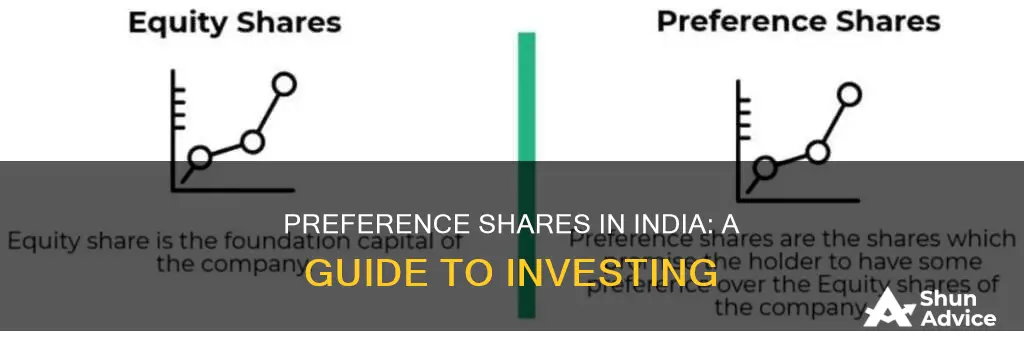
Preference shares are a type of stock that grants shareholders priority in dividends and liquidation. They are similar to common shares in terms of ownership but do not carry voting rights. Preference shares are suitable for investors seeking a steady income without the risks associated with common shares. In India, preference shares can be purchased through the primary or secondary markets, depending on their listing status, and investors must have a Demat account to trade them.
| Characteristics | Values |
|---|---|
| Dividends | Paid out to preference shareholders before common shareholders |
| Voting rights | Preference shareholders do not hold voting rights |
| Priority | Preference shareholders are paid before common shareholders in the event of liquidation |
| Risk | Preference shares are suitable for risk-averse investors |
| Returns | Preference shares offer regular, fixed returns |
| Taxation | Dividend income on preference shares is tax-free up to Rs 10,00,000 |
| Investment | Preference shares can be purchased through the primary or secondary market |
What You'll Learn

Understanding preference shares
Preference shares, also known as preferred stocks, are a type of security that combines characteristics of both common shares and fixed-income securities. Preference shareholders are given priority when it comes to dividend payouts and the distribution of company assets during liquidation. However, they do not have the same voting rights as common shareholders.
Preference shares are suitable for investors seeking a steady source of income without taking on the risks associated with the volatility of common shares. They are also ideal for risk-averse investors as they are considered low-risk investments. In the event of a company's bankruptcy, preference shareholders are prioritised over common shareholders and are entitled to be paid from the company's assets first.
Preference shares generally come with a fixed dividend payout amount, and there are several categories of preference shares to consider:
- Cumulative preferred stocks guarantee that shareholders will receive any unpaid dividends from previous years before common shareholders receive their dividends.
- Non-cumulative preferred stocks do not allow shareholders to claim unpaid dividends from future profits.
- Participating preferred stocks allow shareholders to receive dividends that include a predetermined additional amount if certain conditions are met, such as company profits exceeding a specified level.
- Convertible preferred stocks give shareholders the option to convert their preference shares into common shares after a specified time and within a given period.
- Non-convertible preferred stocks cannot be converted into common shares, but they still retain preferential rights in terms of dividend payouts and capital payback during liquidation.
- Irredeemable preference shares can only be redeemed if the company shuts down or liquidates its operations.
- Redeemable preference shares, also known as callable preferred stocks, can be repurchased by the company at a fixed rate and date or through a buy-back.
Preference shares are a unique type of investment that offers a combination of fixed returns, priority in dividend payouts and liquidation, and reduced volatility compared to common shares. However, it is important to note that they do not provide voting rights to shareholders.
Savings vs. Investment Institutions: Where Should Your Money Go?
You may want to see also

Types of preference shares
Preference shares are a type of company stock that provides dividends to its shareholders. Although these shares offer a fixed dividend, they do not come with any voting rights. Preference shares are issued by companies to raise capital, and the shareholders are considered partial owners of the company.
Cumulative Preference Shares
Cumulative preference shares provide shareholders with the right to receive dividends in arrears. If a company does not make sufficient profits in a year to pay dividends, they will pay cumulative dividends in the following year. Cumulative preference shares are presumed to be cumulative unless expressly stated as non-cumulative.
Non-cumulative Preference Shares
Non-cumulative preference shares, in contrast, do not accumulate dividends. Dividends for these shares are paid only from the current year's net profits. If a company incurs a loss in a particular year, shareholders cannot claim outstanding dividends from future profits.
Redeemable Preference Shares
Redeemable preference shares, also known as callable preferred stock, are a common way to finance large companies. These shares combine equity and debt financing and are traded on stock exchanges. Companies typically have the right to repurchase these shares at a fixed rate and date or by making an advance announcement.
Irredeemable Preference Shares
Irredeemable preference shares cannot be redeemed or repaid during the company's active lifetime. Shareholders must wait until the company decides to wind up its operations or liquidate before receiving any repayment. These shares represent a perpetual liability for the company.
Participating Preference Shares
Participating preference shares offer shareholders the right to partake in surplus profits during liquidation, after the company has paid its other shareholders. Shareholders receive a fixed dividend rate and also share in the company's additional earnings. Participating preference shareholders may also have voting rights or authority over certain decisions, such as the sale of the business or crucial assets.
Non-participating Preference Shares
Non-participating preference shareholders do not share in the company's extra earnings or surplus assets during liquidation. They are only entitled to receive the pre-fixed dividends.
Convertible Preference Shares
Convertible preference shares allow shareholders to convert their shares into equity shares at a fixed rate after a specified time and within a given period. These shares are beneficial for investors who want to receive preferred share dividends and participate in the price changes of equity shares.
Non-convertible Preference Shares
Non-convertible preference shareholders cannot convert their shares into equity shares. However, they still enjoy the preferential benefit of receiving dividends first or during the company's dissolution.
Adjustable-rate Preference Shares
The dividend rate on adjustable-rate preference shares is not fixed but depends on prevailing market rates. This fluctuating rate directly influences the dividend amount received by shareholders.
Calculating ROI on Your Investment Portfolio: A Step-by-Step Guide
You may want to see also

Benefits of preference shares
Preference shares, also known as preferred stocks, are a type of security that offers characteristics similar to both common shares and fixed-income securities. They are ideal for risk-averse investors and are often chosen by investors who have been trading in the stock market for a long time. Here are some of the benefits of preference shares:
Low Risk
Preference shares are considered low-risk investments because, in the event of a company's bankruptcy and liquidation, preference shareholders are prioritised over other shareholders when it comes to compensation. They are paid in full before any other type of shareholder, thus safeguarding their investment.
Regular Returns
Preference shares provide the benefit of regular returns in the form of dividends. However, it is important to note that the consistency of these dividend payouts depends on the type of preference share. Some types, such as cumulative preference shares, guarantee the payment of any missed dividends in the future, while others, like non-cumulative preference shares, do not.
Higher Claim on Company Assets
In the event of a company's bankruptcy and liquidation, preference shareholders have a higher claim on company assets than common shareholders. This means that they will receive a larger portion of the company's assets, reducing the risk of losing their entire investment.
Convertible Options
Some preference shares offer convertible options, which allow shareholders to convert their preference shares into common shares. This provides shareholders with the opportunity to earn through capital appreciation by converting their shares when the stock price is increasing.
Fixed Income
Preference shares typically offer fixed dividends, providing shareholders with a steady and predictable income stream. This makes preference shares attractive to investors who want a guaranteed income without taking on too much risk.
Shark Tank India: Do the Sharks Really Invest?
You may want to see also

How to buy preference shares
Preference shares are a type of company stock that provides dividends to shareholders. These shares are distinct from common shares in that they offer a fixed dividend and do not come with voting rights. Preference shareholders are given priority over common shareholders when it comes to dividend distribution and during the liquidation of a company.
To buy preference shares in India, you will need a Demat and trading account. Here is a step-by-step guide on how to open a Demat account and start investing in preference shares:
Step 1: Choose a Platform
Select a reputable platform or brokerage firm to open your Demat and trading account. One option is India Infoline (IIFL), which offers competitive prices and unique features. You can visit their website or use their mobile app to get started.
Step 2: Provide Basic Information
Enter your basic details, such as your name, contact information, and email address. You will then receive a one-time password (OTP) on your mobile number and another OTP on your registered email ID.
Step 3: Verify Your Information
Enter the OTPs received on your mobile and email to verify your information. After successful verification, you will be able to access the online Account Opening Form.
Step 4: Complete the Account Opening Form
Fill out the online Account Opening Form with the necessary details. A Relationship Manager will then contact you to guide you through the documentation process.
Step 5: Submit Required Documents
Provide the necessary documents as instructed by the Relationship Manager. Once the documentation is completed and submitted, your Demat and trading account will be opened within 24 hours.
Step 6: Start Investing
Once your account is opened, you can start investing in preference shares. Research and choose the companies whose preference shares you want to buy. You can purchase preference shares directly from the company during private placements or public offers, or you can buy them on the secondary market through stock exchanges like BSE or NSE.
Step 7: Monitor and Manage Your Investments
Regularly review your investments and stay updated with market trends. You can also seek expert advice or use online resources to make informed investment decisions. Remember that preference shares are ideal for experienced investors and those seeking long-term investments with substantial earnings.
By following these steps, you can successfully invest in preference shares in India. Remember to consider your financial goals, risk appetite, and the specific features of different types of preference shares before making any investment decisions.
Building an Investment Portfolio: A Beginner's Guide for India
You may want to see also

Differences between preference and equity shares
While both preference and equity shares represent ownership in a company, there are several differences between the two. Here are the key differences:
- Ownership and Control: Equity shares represent full ownership of a company, with voting rights and the ability to participate in management decisions. Preference shareholders, on the other hand, do not have voting rights and cannot participate in internal decision-making. However, they do have voting rights in matters that directly affect their preference rights, such as a reduction in capital or winding up of the company.
- Dividends: Preference shareholders receive fixed dividends, which are paid out before dividends to equity shareholders. In the case of equity shares, the dividend rate is not fixed and can fluctuate based on the company's earnings. Equity shareholders receive dividends only after preference shareholders have been paid.
- Bonus Shares: Equity shareholders are eligible to receive bonus shares from the company, while preference shareholders are not.
- Capital Repayment: During liquidation, preference shareholders receive their capital repayment before equity shareholders. Preference shares are also given priority over equity shares in terms of repayment of capital.
- Risk: Equity shares are generally considered riskier than preference shares. Equity shareholders have a residual claim on assets and earnings, while preference shareholders have a fixed dividend and priority in liquidation.
- Convertibility: Preference shares can be converted into equity shares, but equity shares cannot be converted into preference shares.
- Investment Denomination: Equity shares typically have lower denominations, making them accessible to small investors. Preference shares, on the other hand, often come with higher denominations, targeting medium to large investors.
- Mandatory Issuance: Companies are required to issue equity shares to become publicly owned. However, it is not mandatory for every company to issue preference shares.
- Dividend Payment: Payment of dividends to equity shareholders is optional and depends on the company's profit. In contrast, the payment of dividends to preference shareholders is an obligation for the company.
Investment Management Fees: California's Deductible Expenses Explained
You may want to see also
Frequently asked questions
Preference shares are a type of stock that grants shareholders priority in dividends and liquidation. They are similar to common shares in terms of ownership but do not hold voting rights.
There are several types of preference shares in India, including cumulative, non-cumulative, redeemable, irredeemable, convertible, non-convertible, participating, non-participating, and adjustable-rate preference shares.
To buy preference shares in India, you need a Demat and trading account. You can open a Demat account with a broker or financial institution. Once you have an account, you can purchase preference shares of any company you want through the primary or secondary market, depending on their listing status.
Preference shares offer regular income in the form of dividends, lower risk compared to common shares, and tax benefits on dividend income. They are suitable for investors seeking a steady source of income without taking on the risks of volatility in the common shares.
One risk of investing in preference shares is that they may not offer the same upside potential as common shares in terms of price appreciation. Additionally, preference shares may trade at a discount or premium to their face value depending on the market rate of return, which can result in capital losses or gains for investors.







